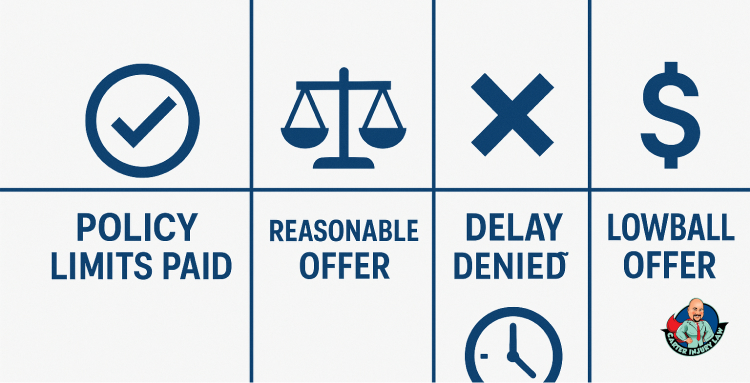
blog
July 15, 2025
What Really Happens in Demand Letters & Settlement Talks Phase

Somewhere between the hospital visits, the calls you didn’t want to make, and the pain you didn’t ask for, time kept moving. You did everything right. You went to the doctor. You answered every email from our office. You waited because healing takes time, and so does justice. And now, here we are. The demand phase.
However, this part isn’t just about documents or deadlines. We’ve been preparing for this moment from the very beginning.
But what happens next… isn't always fair, or predictable. In fact, it’s often the part where the story takes a sharp turn.
1) What Your Lawyer’s Doing Behind the Scenes While You’re Recovering
While you're focused on getting better, we're working behind the scenes to build the strongest case possible.
That starts with your medical records. We request them from every provider you've seen since the incident. Then we go through them line by line. We build out charts and spreadsheets that show not just what was charged, but what was actually paid, what was adjusted, and what you still owe.
That last part matters more than most people realize, because when it comes time to talk settlement numbers, your net medical bills are a huge factor in the negotiation.
And if there’s a doctor or a visit you haven’t told us about yet, let us know—now. We do our best to catch everything, but if we don’t know about a provider, the insurance company won’t either. They won’t consider it in the value of your claim unless it’s in the demand package we send.
And if it’s not in the package, it’s not on the table. As I often say, we scour your records. We build spreadsheets. We make sure nothing is missed.
2) The Demand Letter Gives You Power

When we talk about a demand letter, we’re not talking about a generic form or a polite request. This is a carefully constructed, fully-loaded case presentation that lays out why you’re owed compensation and exactly how much.
We build a full narrative:
Your medical records
The bills
The treatment timeline
The liability story, how the accident happened and why the other party is at fault
The policy coverage involved
And most importantly, how all of it connects back to you. What you’ve been through, what you’re still dealing with, and what it’s going to take to make it right.
We send this out in multiple formats—on CD through certified mail, and if we can, we’ll also fax or email it directly to the insurance company. Because we want to eliminate their excuses. They can’t say they didn’t get it. They can’t say it wasn’t clear.
“In 2023, only 50–60% of personal injury cases settled before trial because early demand packages weren’t strong enough.”
That’s why we don’t just send a letter, we send a message. And it sets the tone for everything that comes next.
3) What Happens After We Hit ‘Send’
Once the demand goes out, the clock starts ticking. Most insurance companies are given 30 days to respond. That’s the general rule but like most things in this process, there are exceptions.
If we’re dealing with a government agency or a large corporation with layers of red tape, they might not get back to us for 60 to 90 days. And sometimes, let’s be honest, we get silence. No offer. No response. Just silence.
Now, that can be incredibly frustrating. You’ve been through enough already, and the idea of more waiting doesn’t sit right. However, we play the long game, and we do it with a paper trail. Why are we giving insurance companies extra time? It’s because we’re showing good faith. That matters down the line, especially if we need to take them to court.
“Under Florida law, insurers must acknowledge and act promptly but delays still plague up to 25% of serious injury claims.”
— Consumer Federation of America
So yes, waiting is part of this phase. But it’s not wasted time. It’s us building the pressure, positioning your case, and letting them know—we’re watching every move they make. Check out this video for an overview of demand letters and settlement talks.
4) Five Possible Outcomes And What They Mean for Your Case
Once the demand letter is out, there are a handful of ways things can go. Some are encouraging. Some are aggravating. All of them are part of the process and we’ve seen them all.
I) Policy Limits Are Tendered
This is the best-case scenario. The insurance company reviews your claim and agrees to pay the full amount of coverage available under the policy. If their insured has a $100,000 policy and they write a check for $100,000, that means they know the value of your case and they want to wrap it up.

II) Reasonable Settlement Offer
Sometimes they don’t offer the full policy, but they come to the table with a number that makes sense. That doesn’t mean we just accept and move on—we negotiate. Our experience lets us read between the lines of an offer.
If it’s a solid start, we go back and forth with them to push it higher. That dialogue can lead to a resolution without a lawsuit and that’s always worth exploring when the numbers are fair.
III) Claim Denial
Unfortunately, this does happen in slip and fall cases, premises liability, or intersection accidents where they think you’re more than 50% at fault. They’ll say, “We’re not paying anything.” When that happens, we regroup and walk you through your options. Sometimes it means filing suit. Sometimes it means digging deeper and giving them more evidence.
IV) Delay Tactics (Triple D)
Deny, Delay, and Defend. It’s about wearing you down. But we’ve seen it too many times to fall for it. If they’re playing games, we move forward. Sometimes that means a lawsuit. Sometimes that means calling their bluff. But it never means sitting back.
V) Lowball Offer

They offer you less than what you owe in medical bills. And while it’s technically “an offer,” it’s not one we take seriously. Negotiating off a lowball can actually hurt your position. If we believe the gap is too wide, we’ll likely recommend skipping the back-and-forth and going straight to litigation.
5) If the Offer Stinks, We File And We’re Ready.
Filing a lawsuit isn’t some dramatic move we pull to scare the insurance company. If they’re not serious, we file.
We’ve done everything in good faith. But if they still come back with an offer that doesn’t reflect your injuries or your bills, or worse, they ignore us altogether, then we pivot.
That said, we never file without your approval. Before anything goes to court, we’ll sit down, explain the process and talk through what filing means for your timeline, your case, and your options.
You’re the decision-maker. We give advice. You give the go-ahead.
Because this is your case. Your future. And when you're ready to take the next step, we’ll already be ten steps ahead. You’ve got a team behind you.
And we’re not going anywhere.
Recent posts











